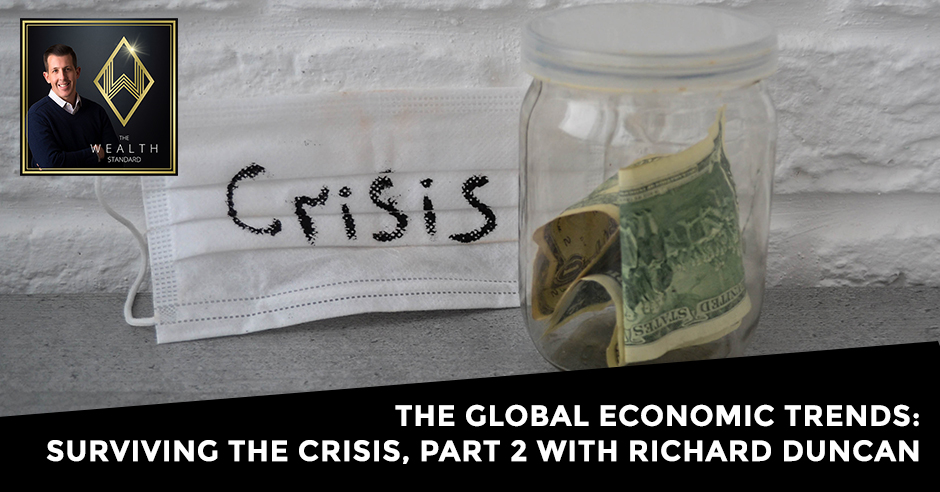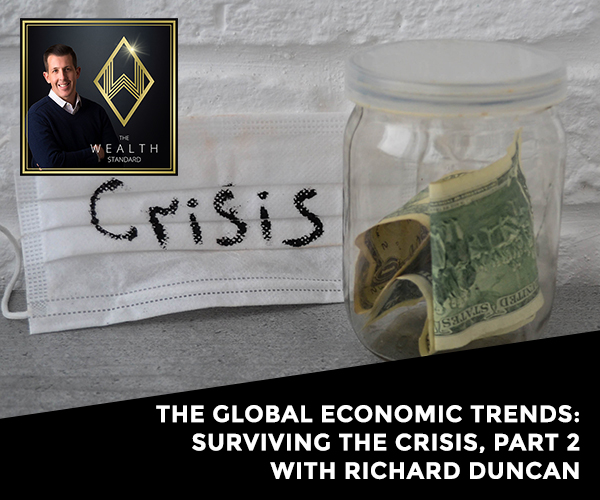The Global Economic Trends: Surviving The Crisis, Part 2 With Richard Duncan
Podcast: Play in new window | Download

In the past, government debts were not paid and just piled up with interest rates that increase every year. In today’s economic crisis, is America facing another era like that of World War II? What is the federal reserve doing to cope with these economically disruptive times? In this part two episode with professional economist Richard Duncan, he joins Patrick Donohoe to touch on the government policy response towards the economy during the pandemic. They also exchange thoughts on the global economic trends and where things can go given the involvement by the Federal Reserve and how banks will be affected in this massive pivot.
Get a 50% discount off a Macro Watch subscription by visiting https://www.richardduncaneconomics.com. Hit the subscribe button and use the discount coupon code: June.
Watch the episode here:
Listen to the podcast here:
The Global Economic Trends: Surviving The Crisis, Part 2 With Richard Duncan
I hope you enjoyed part one of the two-part episode with Richard Duncan, who’s a professional economist. You can check him out at RichardDuncanEconomics.com. He has a fascinating video newsletter. You can use the code, JUNE, to get 50% off. I congratulate you for being here. This is a topic and information that very few people understand. I’m hoping you have taken the time to understand where Richard is coming from and what he sees from his perspective. That’s going to help you to be aware of what’s going on and understand where things can go given the involvement by the Federal Reserve and the government as they tried to stimulate the economy.
One final thing before we get to part two, my good friend, Mike Dillard, has a new community that he is launching specifically to help individuals as they go through a significant change when it comes to employment career work. It’s going to be huge. Mike is the foremost expert on everything digital, anything that has to do with online marketing, sales and creating value. This is a great opportunity. Go head over to TheWealthStandard.com for more information on that. Enjoy part two with Richard Duncan.
—
This is how I look at it. Does debt have a new definition? Debt in the past was something that was ultimately paid back. Is this debt that’s going to be created, never paid back and continues to pile and pile? Does that change? Looking at what you’re alluding to where you use this type of stimulus to invest in innovation in all sectors, mainly the ones that you talked about where clearly whoever wins the race is going to have dominance over certain sectors, case in point, China.
That could be deflationary at some point because ultimately, if you have no cancer or very low rates of cancer, you have a lot of efficiency when it comes to transportation or energy because of that innovation. Isn’t technology in that sense deflationary? Is there ever a pivot? Maybe this is a time to bring in the debate with Ray Dalio and John Mauldin. That was a question I wanted to ask. I’m not even sure if I’m articulating that well. At what point do the tides turn or do they ever turn?
You started off by saying, “Will the debt ever be paid back?” Government debt increased by five times in four years. That would be the equivalent now of US government debt jumping from roughly $20 trillion to $100 trillion in over four years. That’s the magnitude we’re talking about. That government debt in World War II was never repaid. It was rolled over and the economy grew. At the end of the war, there was a consumer boom, borrowing boom and also they have saved during the war. The same governments generally don’t pay back the money. The economy grows and they grow their way out of it. The level of government debt was about 115% in 1946. It came down below 40% because the economy grew. This was despite big budget deficits and a lot of the time starting in the ‘60s and going on afterwards particularly during the Reagan administration, the largest peacetime budget deficits in history.
Looking up ahead though, there are various ways of investing on a scale that I would like to see our government undertake. They could do it the way they did with NASA under one big roof, which worked out pretty well and manage it all by themselves. Most people don’t like that idea these days. Alternatively, the government could undertake these investment programs and invest in these new industries in the following way. The government could act as a big venture capital company and set up joint venture companies with the 10,000 most promising American entrepreneurs, Jeff Bezos, Bill Gates and all the younger ones as well. The government provides lavish funding for these ventures and these industries of the future. It keeps a 60% equity stake. In other words, the public owns 60% of these companies. The entrepreneurs keep 40% and manage the company.
When one of them comes up with a vaccine for cancer, you’re listed on NASDAQ for $10 trillion and the taxpayers keep $6 trillion and this thing pays for itself many times over. In that case, the debt would be repaid and we cure cancer. We cure all the other diseases as well. We stop aging and hopefully, reverse it. People live decades longer, which solves our Social Security and Medicare problems. It makes everyone much happier, healthier, rightly improves the world and everyone lives happily ever after for a very long time in a prosperous and useful world under US leadership.
Maybe transition now to the debate is appropriate. Our monetary policy the way that it exists right now is it’s set up to do what you talked about to make that type of pivot. I know they’ve talked a bit about quantitative infinity, which is even being open to buying equities, not just government securities but corporate securities. When does it pivot to the point where now it takes equity position into companies and goes down this path? Does something have to change on the aspects of how the Federal Reserve operates and the power that it’s given? Can it operate that way and make that impact without changes?
It would continue operating exactly the way it does. It would only be necessary for it to create money and buy the government bonds that the government sells to finance these investments. It would be government debt, government ownership, and fed financing. You referenced Ray Dalio. A few months ago, he published a number of articles on his LinkedIn account and elsewhere called MP3, Monetary Policy 3, which were spot on. He said Monetary Policy 1 was the traditional monetary policy where when the economy overheated or when the economy got weak, the fed would cut interest rates and provide stimulus to the economy that way. That’s traditional monetary policy.
Once interest rates hit 0% during the crisis of 2008, that wasn’t effective. They couldn’t cut rates anymore. They moved on to Monetary Policy 2, which was quantitative easing where the fed would create money and buy long-term government bonds where the yields were above 0%. By buying the long-term government bonds with the newly created money, they can push up the price of the bond. They can drive down their yields to very low levels, in fact, at any level they will want it and stimulate the economy that way. He said we’ve reached the point where even the long-term interest rates are very close to zero.
The government does not pay back the money. The economy just grows its way out of it. Click To TweetMonetary Policy 2 is also losing its effectiveness and also has some undesirable consequences and side effects as well. He said, “In the next economic downturn, we’re going to have to move to what he called Monetary Policy 3, which would be a combination of increased government borrowing financed by increased paper money creation by the fed. That’s exactly what we have now, MP3. It’s going on such an enormous scale. You could call it MP3 cubed because it’s on such an enormous scale. There was a lot of debate about that at the moment. In particular, John Mauldin, someone I admire who publishes a newsletter called Thoughts from The Frontline. He’s a very intelligent and nice man that I’ve had the pleasure to meet. He argued the complete opposite. He said, “That’s wrong.” What the government needs to do is to raise taxes and pay down government debt. Government debt is way too high already and we need to go back to some austerity through higher taxes and get the big debt levels down. With all due respect, that would be absolutely disastrous. That would cause credit contraction. That would cause a severe recession, that would get worse and worse until they stopped doing that and reversed it entirely.
I published a number of macro watch videos called The Great Debate, laying out the arguments of both sides and siding with Ray Dalio. Now that the crisis has struck, no one could have anticipated this, but even after a brief period of resistance, John Mauldin is now all in with MP3. He said this is the right policy. You have to have increased government spending. It has to be financed by the fed. This is what we have to do. The debt is going to be a lot higher. We’re going to have to learn to live with it. That debate is over. Thank heavens it was decided in the right direction because if we had gone the other way, we would now be in a world with lots of people who were very hungry and desperate.
I have a few more questions because this is a deep conversation, maybe not for you, but for our audience and me as well because there’s so much that our economy and world is built on. If you were to pivot to something different, going this direction as opposed to the direction we’ve been going for 60, 70 years, that may be catastrophic. Looking at the vulnerabilities that the economy has, what I’m hearing you say for all of this is whether it’s sensitivity to disruption like the COVID-19 impacting productivity and markets being sensitive and selling off. That would exist if there was a gold back where there was a dollar that was backed by something tangible. There would be so much restriction there that there wouldn’t be as much expansion.
All things being equal, whether you have this type of monetary system or that type of monetary system, there’s never going to be a utopian perfection. Where we’re at right now, the best way to continue to grow in the way that we’ve been growing is to maintain the same idea but potentially scale it up and be more directive toward it. That’s where you stand as far as if you were in Jerome Powell’s seat or maybe a policy or lawmaker’s seat and wanted to make a difference. It would be using our reserve status as well as the ability to monetize debt and direct it toward the innovative technologies that are going to make life better for everyone.
We need to get past the economic orthodoxy that was appropriate for the previous economic system we lived under when dollars were backed by gold. You could call that system capitalism. I tend to call our new system creditism because it’s driven by cryptic growth. We need to understand we have a different kind of economic system now and the rules are different. It works differently. We need to understand what these rules are. We need to understand how the economy works now. We need to master the rules and make the most of it.
What we will find is that this creates an unprecedented opportunity in human history where it is possible as we’ve seen over the last several years where the government borrowed trillions and trillions of dollars and have the fed finance what was the third of that with newly created money without causing inflation. It has given us the opportunity to invest trillions of dollars in the years ahead in the industries that will enable us to do some new technological revolution and radically improve human happiness and well-being.
It’s useful to put this into historical context a bit more even looking at what happened when we’re living under the rules of our previous economic system when gold was backed by money. Let’s start with World War I. The world was on a gold standard. The war broke out in Europe in 1914 and all the European countries went to war. They couldn’t finance that on a gold-back monetary system so they started printing a lot of paper money. The US didn’t enter the war until 1917. Up until that time, the United States sold war materials to both sides, lots of them. They insisted on being paid with gold so there was a huge surge of gold inflows into the United States.
The monetary base expanded radically. The banks could lend a multiple of the amount of gold deposits they have. We’ve entered the war in 1917. The war ended in 1918. Government spending went up during the war. All that created a big economic boom in the United States. After a little while, the boom turned into a bust. The famous depression of 1921, which the Austrians economist and libertarians often referenced as being an example of how things should be managed. That depression didn’t last very long.
It was quite severe, but it was short and sharp. The government didn’t do anything effectively. What the Austrians don’t mention is that the reason we pulled out of that depression of 1921 so quickly was because that was the decade the consumer credit and consumer financing was born. The consumers had almost no debt in 1921, but they started buying automobiles on consumer credit, sewing machines, refrigerators and everything else that you could buy on consumer credit.
More and more of them got mortgages and moved into houses out of the city in the suburbs. There was an explosion of consumer credit that occurred all during the ‘20s that pulled us out of the 1921 depression. In 2008, that wasn’t possible to repeat that playbook because the consumers were already heavily indebted. They weren’t going to pull us out of anywhere except down into a depression. In 1930, the consumer has reached the point in the US where they had too much debt. They couldn’t keep repaying their debt. The consumer credit bubble of the 1920s hopped.

Global Economic Trends: Government debt increases five times in four years.
At that point, everyone was a capitalist and believed in laissez-faire and market forces. That was ingrained conventional wisdom in everyone. President Herbert Hoover was the President. He wasn’t an enormously talented individual. He wrote a three-volume autobiography, which I read all up. The man was an extraordinary individual, but he believed in market forces as everyone else did, laissez-faire and he didn’t do very much of anything.
By the time Franklin Roosevelt took office in March 1933, the economy had collapsed into a depression and a third of the banks failed. At that point, the fed was not free to create as much money as it wanted because it had enough gold to back the dollars that it created. It wasn’t free to do quantitative easing because they can only do quantitative easing by creating money. You can’t create money back then if you don’t have gold to back the money. They didn’t have enough gold to back the money.
On top of that, the government didn’t do very much in terms of fiscal stimulus. They didn’t triple their government debt over the next decade the way that we did after 2008. In 2008, the government had trillion-dollar budget deficits, the fed finance them. That’s why we didn’t collapse into a great depression this time because we weren’t constrained by the rules of the gold standards anymore. We had a bubble. We managed to keep the bubble inflated. We’ve kept the bubble inflated for several years.
Imagine if things have collapsed, we wouldn’t have iPads. We would have never seen the Game of Thrones. A lot of good things have happened in the years that wouldn’t have happened if the economy had flattened into a depression like during the 1930s. We never came out of the depression of the 1930s driven by market forces. We came out of the Depression because of World War II and the massive expansion of government debt. Government debt expanded five times in four years and that ended the depression. The fed financed a significant amount of that government debt by creating money and buying government bonds under emergency powers. The Federal Reserve Act had to be changed to allow the fed to create more money during the war. It wouldn’t have been able to do as the Federal Reserve Act of 1913 was originally written.
The Act has been amended a number of times.
Numerous times and every time making it easier to extend credit. One of the amendments to the Federal Reserve Act is called Section 13(3), which essentially allows the fed to lend money to institutions that normally wouldn’t be permitted to lend to. In other words, all kinds of institutions like brokers and dealers, mutual funds, and essentially anyone in the financial industry who wants to borrow from the fed can now do so. Whereas originally the fed could only lend to commercial banks and member banks of the Federal Reserve System. Now they can essentially lend to anyone against any collateral practically. They’re using these emergency measures now very aggressively. At last count, they’ve used this Section 13(3) emergency rule in ten different cases of how they’re extending loans to every corner of the financial system.
I have a few more questions. It’s been enlightening for me because in the end, the way in which we came out of 2008 and 2009. I look at the school of thought that’s bailing out banks or stimulating the economy using monetary policy. People defined what happened in a few different ways. I look at what happened, as you alluded to the innovation that occurred, unemployment at low levels. There were unintended consequences, but they would have been there anyway where individuals, businesses overextend themselves. When they overextend themselves, when there is a blip or a black swan, it throws them off. Whether they had debt or not, they would have been thrown off. I look at what’s going on with what the fed is going to do in the future.
To you, it’s probably not surprising and continuing to happen to prop everything up. Those are the tools that they have. Those are the tools they’re going to use. Looking at a few other elements which I’m curious about because I don’t know a lot about it. I know that there is an element of that which is the credit swamps. I know a big part of what happened in 2008, 2009 was the result of insurance being purchased on assets that if they declined in value, these insurance policies would pay off.
They were both swaps of those that owned the underlying security than those that didn’t. I know that it’s grown on multiples as far as these types of contracts as it relates to credit defaults. The businesses are flailing. You have Virgin Atlantic that’s begging for money. The airlines need money. A few of them have already been downgraded. What role do these derivative contracts have in influencing what the fed can do? In essence, interest rates are interest rates. They’re all in a sense have some interdependency.
The derivatives market is such a black box. No one knows what’s going on inside there. One of the largest banks, I was looking at the balance sheet or the annual report by chance. If I recall correctly, their notional value of derivatives exposure was $46 trillion. Most of those are nets-off in their ideal world. The exchange value is $50 billion or something like that. That assumes that none of the counterparties go bankrupt. The number of derivatives for 2008 were expanding so rapidly that we would have quickly hit quadrillion dollars’ worth of notional value of derivatives in total that suddenly stopped in 2008.
Back then, you cannot create money if you do not have gold. Click To TweetBanks don’t go bankrupt unless the government declares them bankrupt. Without all the government intervention that we have, all the banks would be in the process of failing. If banks fail, everyone’s deposit evaporates unless the government prints money and replaces the deposit guarantees. If you’re going to do that, you might as well save the bank to start with, it will be cheaper. My point is that they have to keep the banks alive. If they’re massive problems in their derivatives position, they’re not going to make it public. They’re going to cover them over and try to re-flight them.
Fannie and Freddie had very large derivatives positions when they failed. Why didn’t the government completely nationalize them or why didn’t the government nationalized Citi and Bank of America when they had to have large equity injections from the government? If you’d nationalize these things and look very carefully, who knows what might end up being the negative net worth of these things given their derivatives position? No one knows. You don’t want to own them. You don’t want to be responsible for the negative losses that could potentially come out of these things.
I said earlier that the government manages the economy. That’s not the same thing as they are planning what’s going to happen. Things happen and then they respond to what happens. They made many big mistakes along the way. One of them was deregulating the banks too much and allowing them to run out of control and buy up stockbroking companies and insurance companies. In other words, they repealed Glass-Steagall, which separated stockbroking from commercial banking.
Another thing is they allowed the derivatives to go unregulated, which was completely insane. Things happen in a democracy. Many people talk about conspiracy theories of this or that. From what I’ve seen of Washington, no one is in control. There are certain groups and individuals who are pushing the lobbyists to get individual things that they want. This is far too complex for anyone to control. The bank lobbies push for deregulation. They gave the congressmen and the senators enough money that they got what they wanted in terms of campaign financing.
They were deregulated. Now, they’re too big to fail and can’t be allowed to fail. That’s how we got here. That’s all very unfortunate but that’s the way things have evolved. We can’t allow the banks to collapse. It’s hard to project out into the future what would be the ideal policy. Given the fact that we need credit to keep expanding. If you were to nationalize the banks, what are you going to do with them? I don’t want to speculate too far, but perhaps we should do you think more in terms of not allowing buybacks by the banks or other corporations and capping executives’ salaries. Not only at banks but in other major industries and make them all take a much more long-term focus. Rather than basing all their compensation on their share price performance over the quarter. That’s certainly something that needs to be well thought through before anything radical can be done. That can wait until after we’re out of this potential catastrophe.
The last question I was going to ask relates to the stimulus that happened as well as what’s most likely to come, which is probably more stimulus in relation to getting people back to work. Who knows what’s going to happen with employment once they reopen states and economies? You look at other stimulus programs, whether it’s real estate related. If you’re the audience reading these different points about the economy and how our economy works right now, what the fed is likely to do as things unfold based on the pandemic, what would you be paying attention to you? What are the signals? What are the signs? What news are you watching and paying attention to in order to tell you what is going to be some of the opportunities available? What are going to be the end results of the government’s involvement? What that’s going to do to the economy, interest rates, investments, assets and so forth?
The most important thing that’s going to determine whether this is a recession or a very bad recession or a depression. It’s still hands-on the size and the speed of the government’s policy response in terms of how much the government supports the economy through these rescue bills and how much the fed creates in terms of paper money creation, so far so good. There was a very alarming piece of news that I read. Senate Majority Leader Mitch McConnell said, “Hold on here, that’s getting too high. Let’s wait. We’ll take a look and see how things are going before we have more government rescue programs. More government deficit spending.” If that sentiment spreads and we slowed down on the amount of support the government deficits are providing to the economy, everything’s going to collapse. Mitch McConnell will own this depression and will be vilified throughout history for such stupid policies.
We can deal with the debt. We can’t survive an economic collapse. Perhaps we could survive it but we won’t look the same when it’s over. That’s the main thing. What we want to see for a positive outcome is more and more support programs so that the economy doesn’t collapse. We don’t know how long the virus is going to collapse. We don’t know how long we’re going to have tens of millions of people unemployed. As long as we do, the government is going to need to keep sending them checks. We’re going to continue to need to keep our small and medium-sized businesses in business and even our major corporations and the banks. We have to prop up the economy no matter how much it costs or how long it takes. We can afford this. We must do this. That above everything else is a signal you want to watch for.
If that goes the wrong way, look out below. You can’t see how far we could fall. Other than that, I don’t know. Do you want to buy stocks? I don’t give specific investment advice. Even in good times, stocks are very risky. My personal experience, I started off working in stocks in Hongkong in 1986. The first twelve months I was in Hongkong, the stock market went up 100%. The Hongkong economy that year was growing by 13% GDP growth. Everything was rosy. I woke up one morning and Wall Street had fallen 23%. In October ’87, the Hongkong stock market was closed for two weeks, but when it reopened it fell 50%. My stocks, which were especially speculative, fell at about 90%. Even in a booming economy, bad things can happen to good people when it comes to stocks. If you’re feeling lucky and you think the fed is going to prop up the stock market, then roll the dice. If things go wrong, stocks are very expensive going into this crisis now that earnings are collapsing, they’re still very expensive based on any PE valuations so don’t ask me.
It’s one of those things if there is stimulus, that’s a signal. That’s a sign. If there isn’t, that’s also a sign. It can go a few different directions. We haven’t seen the extent of the economic disruption. There’s been zero productivity for almost a month and a half going on two months most likely. We’re getting quarterly earnings, who knows what going to be in the second quarter given all of this disruption?

Global Economic Trends: Monetary Policy 3 is a combination of increased government borrowing financed by increased paper money creation.
The stock was bought on the day the fed announced QE Infinity and then it rebounded 25% or so. That’s the reason the government support. Who knows what will happen next? I do think the fed will try very hard to prevent the stock market from falling more than 25%. They’ll pull out all the stops. They’re already buying junk bonds. If push comes to shove, they will buy stocks directly. They will not let the stock market fall 50% or 75% in my opinion even if they have to jump in the market and buy them directly. Asset pricing deflation has been the supplement to credit growth over the last several years.
Our economy depends on asset prices staying high. They’re going to work very hard to try to keep them high and they’re going to work very hard to keep them from completely evaporating. Even if that means the Federal Reserve Act has to be completely revised once again to allow direct purchases of stocks. If that’s what it takes, that’s what they’ll do. It’s a very dangerous game. Personally, for individuals who want security and control over their own lives owning land with houses on top to rent out is a good approach.
Land, they’re not making any more of it. You can generate rental income from having a house and renting it out. You can grow food on top of the land. No one’s going to steal your land from you and it’s going to be there when you wake up in the morning. Like gold, perhaps all this money creation will cause gold to keep moving higher. If gold moves higher, land prices will also move higher for the same reason. If gold falls a lot, the land will probably fall a lot as well. At least you’ll still have rental income and you won’t have to pay anyone to store your land. You won’t have to worry about someone coming in your house and stealing your land. For security approach toward developing a portfolio of rental properties, not in condominiums, which can be built forever, but land with houses is a secure long-term approach for people who want to have income insecurity over the long run in my opinion.
It’s one of the assets that is easiest to leverage. Leveraged assets are the ones that fall in line with what our monetary policy is because asset prices go up because of leverage.
You have more danger there as well. You have to realize that if rents can fall a lot more than you might imagine more than we’ve ever seen before if this crisis persists, all the rental contracts are going to be torn up. Too much leverage then you can fail. It’s a matter of striking the right balance. Everyone has their own risk tolerance levels, but you do have to be aware of the risks that you may not be receiving the rent you anticipate.
With leverage, you could be over-leveraged. You can be under-leverage. You can have no leverage. There’s always going to be some downside and upside to each. It’s the balance that makes sense. Looking at where the economy goes, the influence whether it’s the Federal Reserve or whether it’s the government. You look at the Treasury secretary and you look at this being an election year, they seem to know what they’re doing. The response was quick. I look at whether Mitch McConnell is saying what he did. There’s always going to be those voices that have differing opinions. At the same time, you’ve caused me to realize that if there isn’t a continuation of the monetary policy that we have, there is an alternative, but it is not pretty at all.
There are a lot of things to be concerned about. If there is intervention and it gets to different levels, those are the signals to know that if this happens, this is likely where the economy is going to go. This is likely where the opportunities are. Maybe say one additional thing, Richard, in regards to the perspective you have when it comes to governments taking a different turn and making an investment in innovation. What have you seen to lead you to believe that is a potential direction that the United States would take?
I’m glad you asked that. In November 2019, there is a publication by the National Science Foundation. It comes on once every two years called Science and Engineering Indicators. When it was published in November, it indicated that for the first time in history, China had invested more in research and development than the United States did. If that trend continues, they would invest 40% more by the end of this decade in research and development than the US. Around the same time is when China rolled out 5G in 30 Chinese cities, which is no doubt is many more Chinese cities. Senate Minority Leader Chuck Schumer made a speech in Washington before a conference of the defense establishment.
The conference was on artificial intelligence and what the US policy should be. Everyone there was alarm by these developments and China getting ahead of us. He proposed in a short speech he made there. He said he was going to propose that the United States government invest $100 billion over the next five years in artificial intelligence and the other industries of the future. He named several of them, robotics, quantum computing, and the usual ones you would imagine. That was the first indication where the policy establishment in Washington was waking up to our new Sputnik moment where we needed to radically change our thinking about the desirability of government investment.
That was the first step and an encouraging one, but $100 billion, I’m sorry to say, is not going to do it over five years. That would be $20 billion a year. China would still be miles ahead of us. There’s no point for the United States to be talking in terms of billions of dollars. We need to be thinking in terms of trillions of dollars. As we have seen, in the last couple of months, we’ve spent $2 trillion coming up $3 trillion. This is the thinking we need to apply to our national security because it is a threat. We are in danger. We are going to be surpassed. The consequences with China may be a benign sovereign. They may not be.
The economy depends on the asset prices staying high. Click To TweetOnce they’re in the lead, we will never get it back. I’m not anti-China. I’m certainly not anti-Chinese. I’ve lived in Asia for most of my life. They’re great people. I want the United States to be a global leading power for generations to come and there’s no reason we cannot be. We can afford it and that’s what we need to do sooner. One possible good thing that could come out of this crisis is to demonstrate that it is possible to spend trillions and trillions of dollars and finance it with trillions and trillions of dollars of paper money creation without creating lots of inflation in a very short period of time. If that proves to be true, we need to jump on that and start investing trillions and trillions of dollars in our future and our national security. Along the way, as I’ve said several times, cure all the diseases, expand life expectancy, make the world a much better and happier place for everyone.
Now is one of those prime times because you have a shift in the generation that has governance, whether it’s over businesses, other leadership or into positions where it’s a younger generation. The older generation is retiring and taking a step to the side. The younger generation now can take that type of investment capital and know what to do with it as opposed to an older generation that may not have had the wherewithal to do anything with it. That’s also an interesting coincidence. There is that type of threat. I know Schumer is older, but that’s a good sign. I didn’t know that he had said something like that. This is like a distraction. Hopefully, they can keep on that trajectory.
That’s a good point. A lot of young people now are very much in favor of Medicare for all or free university education. Those are certainly admirable goals. My concern is that we can spend enormous amounts of money treating diabetes, heart disease, and other diseases or we can cure those diseases with the same amount of money forever. We can cure all the diseases if we invest. If we spend this money treating the diseases for everyone, we may not have enough money to cure them. My focus would be we need to have social safety nets for as many people as we possibly can. We’re so far behind most civilized countries in that respect. We have to do better. We can afford to invest on a scale large enough, not just to treat everyone with diseases, but to cure all the diseases.
That’s a conversation for another day as far as the wealth gap and how it was one of the consequences associated with how much prosperity there was over the last decade. It was only amongst those that owned assets. We can go down that road next time. Maybe that next time is when your new book comes out. It sounds like you’ve postponed it a little bit. Do you have a date or a timeframe in which that’s going to come out?
This is the first interview I’ve ever talked about this book other than I got very brief mentioned. I don’t have a timescale. We’re going to have to wait and see how large the government debt becomes and what the consequences are. The book was in my mind was pretty much ready to go, 21 chapters written and rewritten. It was nearing completion at long last. With my business is Macro Watch, which is a video newsletter. Every couple of weeks, I upload a new video, essentially me doing a PowerPoint presentation, discussing something important happening in the world and how that’s likely to affect asset prices, stocks, bonds, commodities, currencies, etc.
Because of this business, Macro Watch, I can do research for my book, turn them into videos and upload them for Macro Watch along the way. Much of what this book contains can already be found in the Macro Watch archives over the last couple of years, which contained well-over 50 hours of videos and a number of courses including one on monetary policy, one on China’s economic crisis, one called Capitalism and Crisis, and another one called How the Economy Really Works. I hope your audience go visit my website at RichardDuncanEconomics.com and check out what’s there. If you’d like to subscribe to Macro Watch, I’d like to offer them a 50% discount. If they use the discount, go to the Richard Duncan Economics, click on the subscribe button when prompted and they can use the discount coupon code, JUNE. At the very least, they could sign up for my free blog and follow my work that way.
We also have an overview of what Macro Watch is. These are 10, 15-minute videos. They are very concise and easy to understand. At the same time, because of how quickly things are going, not having an understanding of basic fundamentals of economics and specifically how the monetary aspect of the global society works, it’s going to be hard to know what people were talking about and what direction things are being taken. You can sit on the sidelines or be a deer in the headlights or you can step up and learn about economics, understand and think intelligently about it, and understand the implications of it one way or the other. The direction that helps you and benefits you as opposed to the one that doesn’t.
People want to understand how the economy works and this new economic system that we have. Macro Watch will teach them. It’s not very complicated. I use lots of charts. It’s all very clear. I highly recommend it.
You make it easy to understand the way in which you approach it. The graphs are not these incredibly insane and difficult to understand graphs. It’s very well put together. Richard, I greatly appreciate this time. It’s helped me to think through a few things. When you get closer to having the book launch, let’s get back on the horn or maybe even earlier as things unwind, unravel and start to piece back together. I’d love to have you back on.
I’d love to do that. I’ve enjoyed our conversation. Congratulations on your success. You’ve seemed to be doing very well with this show and your other businesses.

Global Economic Trends: The government policy response through rescue bills determines a recession or an awfully bad depression.
I’m one of those naturally curious and if there’s business there, great. If not that, there’s so much opportunity. In our day and age when we have an incredibly easy way to communicate with people. You’re in Thailand, but yet you have videos that you post and you get revenue from that. It’s is an amazing world that we live in. I appreciate you saying that. It’s been a fun ride. It’s lonely because I have nobody in my office and a bunch of people on my team. We’ll make this work too.
If you think of opportunities that we can both participate in, let me know. If you can recommend me as a speaker to other shows or friends or any way support the growth of Macro Watch and finance my books, that would be very much appreciated.
I planned on it. I have some connections in areas that would benefit from understanding your perspective. Thank you so much for reading. Thanks for all of your support and we’ll talk to you next time.
Important Links:
- RichardDuncanEconomics.com
- Mike Dillard
- MP3, Monetary Policy 3
- Thoughts from The Frontline
- Science and Engineering Indicators
- Macro Watch
- Blog – Richard Duncan
About Richard Duncan
 Richard Duncan is the author of three books on the global economic crisis, including the international bestseller “The Dollar Crisis: Causes, Consequences, Cures,” which forecast the global economic crisis of 2008 with extraordinary accuracy.
Richard Duncan is the author of three books on the global economic crisis, including the international bestseller “The Dollar Crisis: Causes, Consequences, Cures,” which forecast the global economic crisis of 2008 with extraordinary accuracy.
Since beginning his career as an equities analyst in Hong Kong in 1986, Richard has served as global head of investment strategy at ABN AMRO Asset Management in London, worked as a financial sector specialist for the World Bank in Washington D.C., and headed equity research departments for James Capel Securities and Salomon Brothers in Bangkok. He also worked as a consultant for the IMF in Thailand during the Asia Crisis.
He is now the publisher of the video-newsletter Macro Watch.
Love the show? Subscribe, rate, review, and share!
















